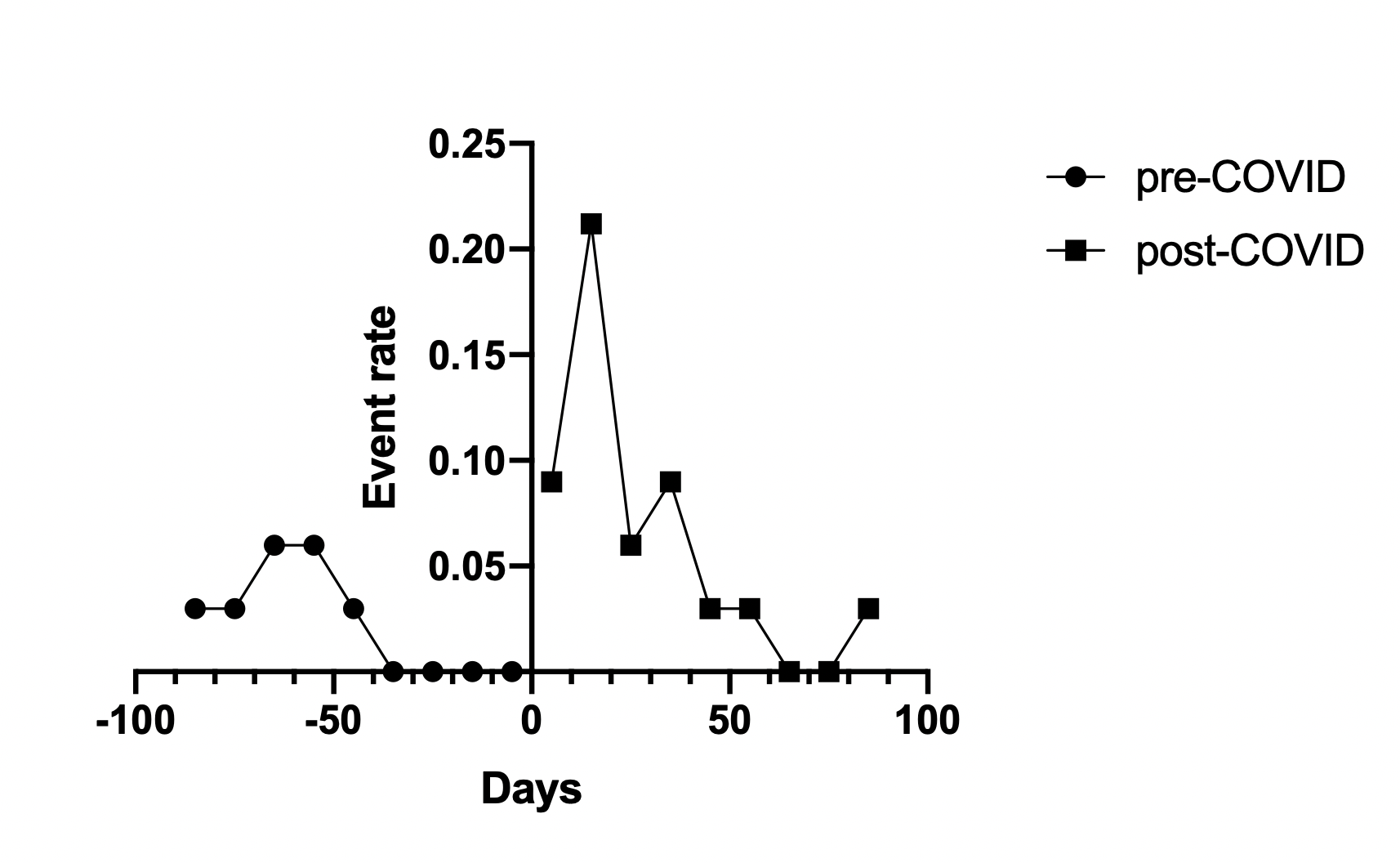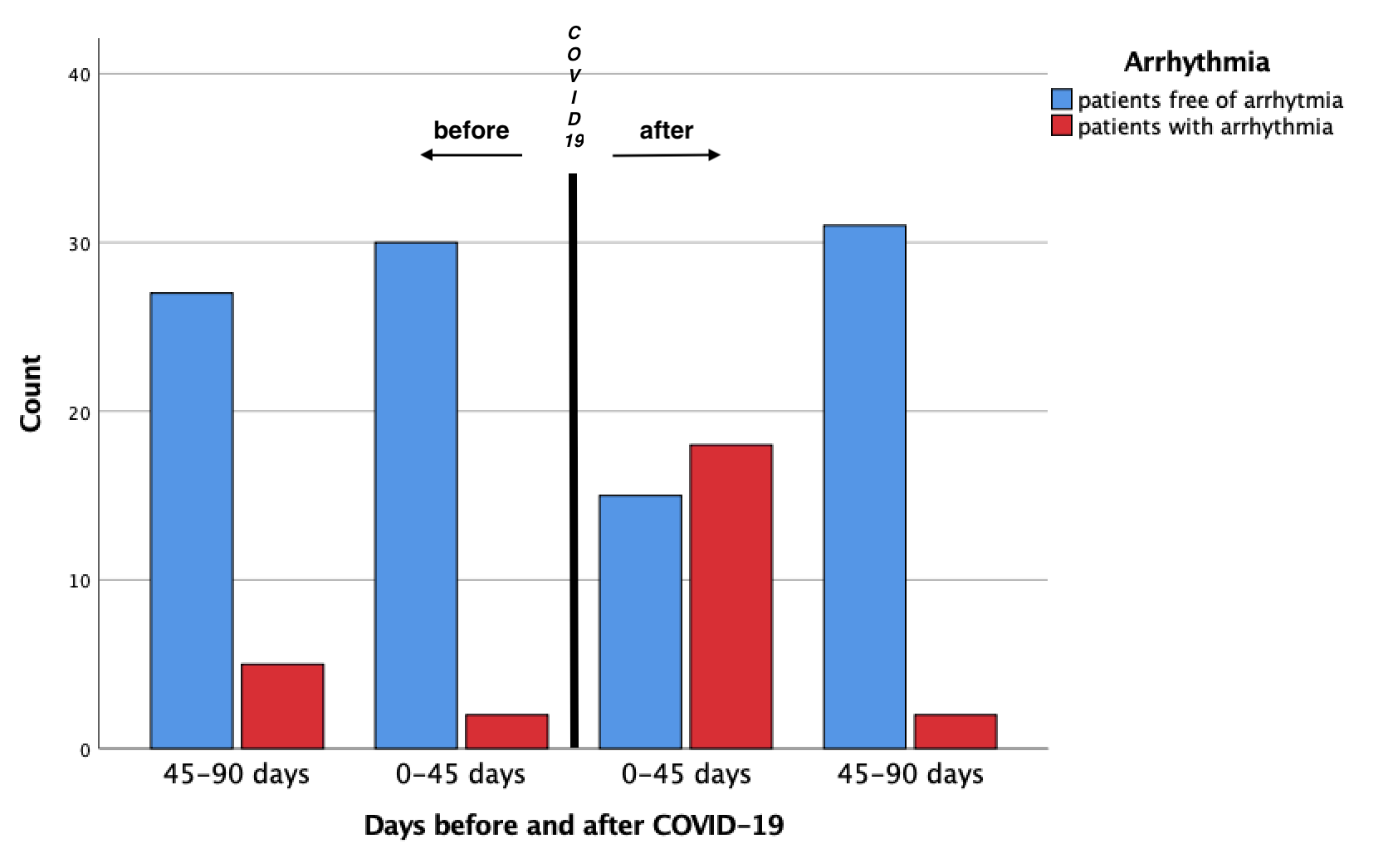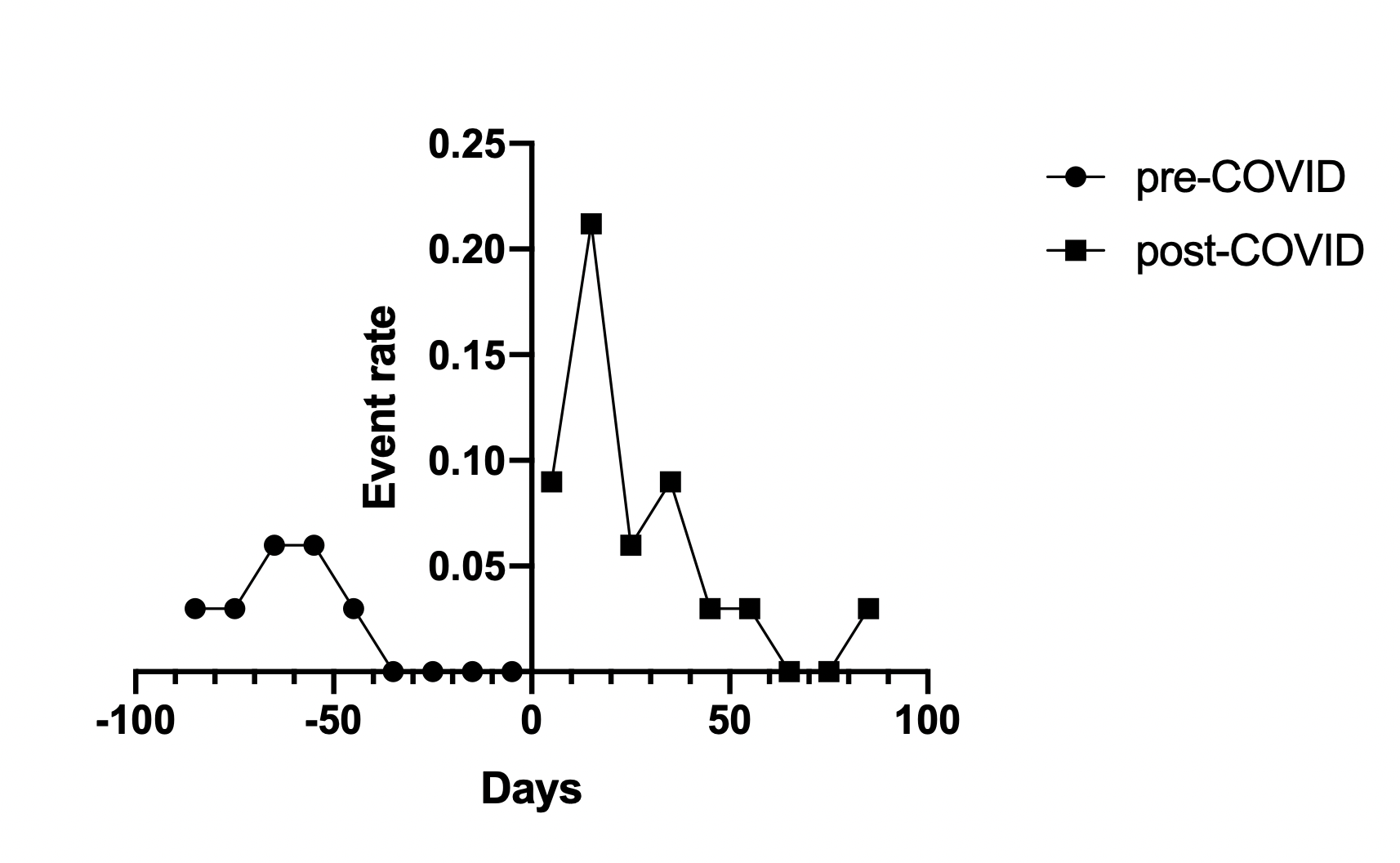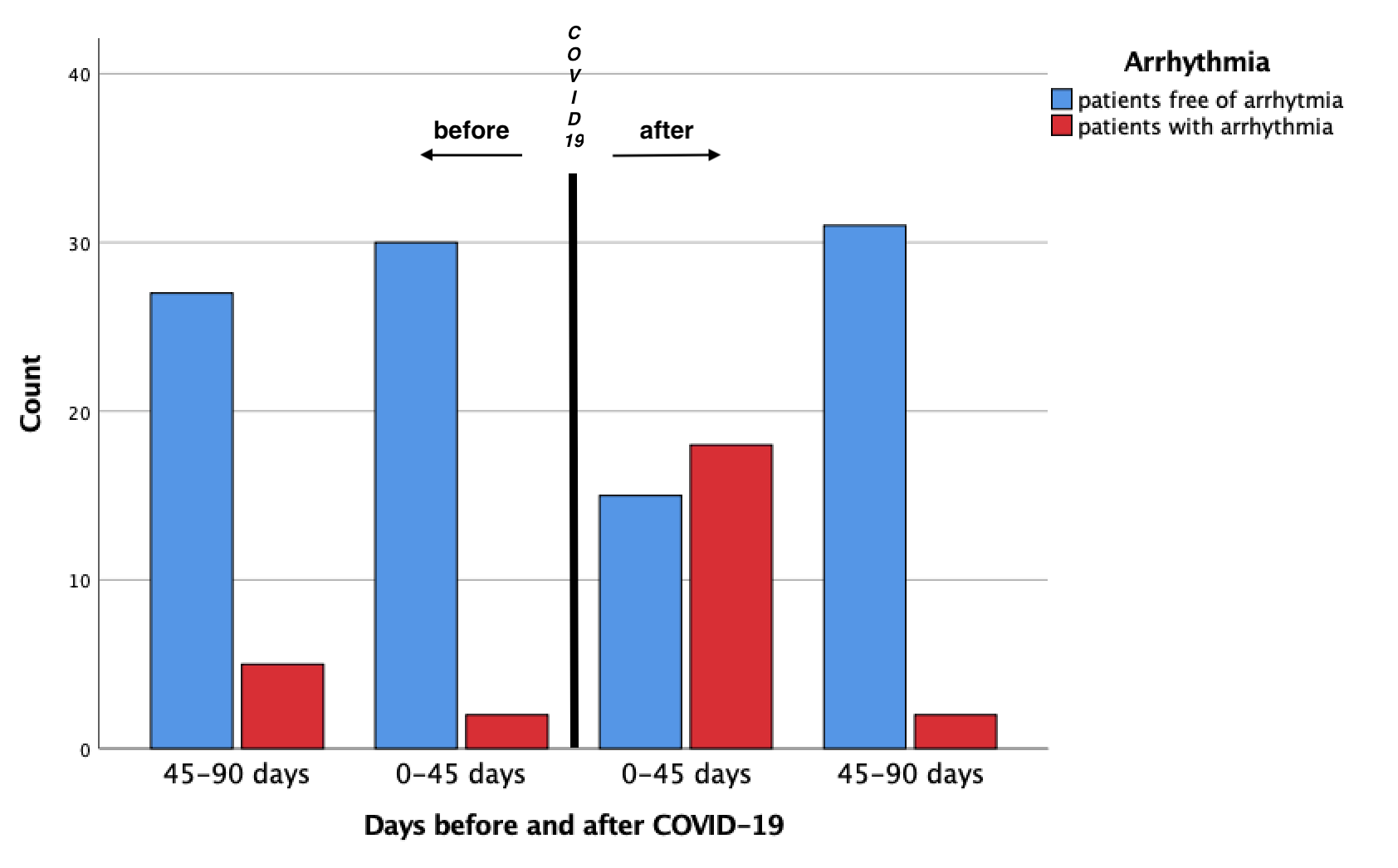AUCTORES
Globalize your Research
Research Article
*Corresponding Author: Mujdat AKTAS, MD. Department of Cardiology, Prof. Dr. Cemil Tascioglu City Hospital İstanbul, 34384 Turkey.
Citation: Abdulcebbar Sipal, Mujdat Aktas, Tayyar Akbulut, Faysal Saylik (2022) Impact of Covıd-19 Pandemıc on Severe Ventrıcular Arrhythmıa and Icd Therapy. J. Clinical Cardiology and Cardiovascular Interventions, 5(6); DOI:10.31579/2641-0419/251
Copyright: © 2022 Mujdat AKTAS, This is an open-access article distributed under the terms of the Creative Commons Attribution License, which permits unrestricted use, distribution, and reproduction in any medium, provided the original author and source are credited.
Received: 03 February 2022 | Accepted: 22 April 2022 | Published: 29 April 2022
Keywords: covıd‐19; ventricular arrhythmia; ımplantable cardioverter-defibrillator
BACKGROUND AND OBJECTIVES: The regular clinical follow-up of the patient with the implantable cardioverter-defibrillator (ICD) device was seriously affected by the COVID-19 outbreak. Due to the high risk of contamination, patients didn’t admit to the clinics for the ICD device control. It has been observed that arrhythmic events increased during the COVID-19 outbreak. In this study, we aimed to investigate the frequency of severe ventricular arrhythmias and ICD device therapy in COVID-19 patients with ICD.
METHODS: In this single center-observational study, we assessed severe ventricular arrhythmias and ICD therapies by analyzing recorded data of 33 patients (24 males, 72.7%) 3 months before and after getting COVID-19 during the COVID-19 pandemic in Van, Turkey, between 15 August 2020 and 15 January 2021.
RESULTS: Before the diagnosis of COVID-19, 6 ventricular tachycardias and 1 ventricular fibrillation episode were observed. When we analyzed the records after the diagnosis COVID-19, 17 ventricular tachycardia, and 3 ventricular fibrillation episodes were observed. Considering the ICD device therapies, 5 of these severe tachyarrhythmias were terminated by anti-tachycardia pacing (ATP) and 2 with shock therapy before the diagnosis of COVID-19. After the COVID-19, 14 of them were terminated by ATP, and 6 of them were terminated by shock therapy.
CONCLUSION: The effects of the COVID-19 pandemic, especially on ventricular arrhythmia, have not been reported sufficiently. In our study, it was observed that life-threatening ventricular arrhythmias and the ICD therapies were increased in patients with COVID-19, especially in the first month after the diagnosis of COVID-19.
Although COVID-19 (Corona Virus Disease 2019) mainly affects the lungs, extrapulmonary complications such as cardiac complications are also increasing day by day. [1] SARS-CoV2 (severe acute respiratory syndrome-coronavirus-2) infection is associated with many pro-inflammatory mediators that may play a role in the development of cardiac arrhythmia and complications. In a single-center study, the cardiac injury was observed in 19 percent of the hospitalized patients. Therefore, it is plausible that these patients have an even higher risk of cardiac arrhythmias.
Ventricular arrhythmias mostly occur in settings associated with an increased sympathetic tone, including physical activity, illness, and emotional distress. [2] Lung injury and hypoxemia caused by the SARS-CoV 2 epidemic may cause irregularity in the electrical activity of the myocardium. In addition, SARS-CoV2 can directly damage myocardial cells and the electrical conduction system of the heart. Again, COVID-19 infection can aggravate the underlying cardiovascular disease, and the release of endogenous catecholamine may disrupt the electrical activity of the myocardium due to increased anxiety.
Patients with ICD (implantable cardioverter-defibrillator) device are always at risk of life-threatening ventricular arrhythmia (VA) and sudden death. We analyzed the data of the old ICD patients to determine whether the device therapy and ventricular arrhythmia burden have increased after the diagnosis of COVID-19.
This is a single center-observational study. Patients with previously implanted ICD devices (single and dual-chamber ICD) due to systolic left ventricular dysfunction or cardiac arrest and syncope and who were positive for COVID-19 PCR (+) (Polymerase Chain Reaction) were included in this study. For this study, 50 patients' ICD device records were reviewed in the cardiology clinic. 33 patients who met the inclusion criteria were included. Data obtained from the ICD of 33 patients (24 males) who were admitted to the clinic for regular pacemaker control between August 15, 2020, and January 15, 2021, and had positive PCR results for COVID-19 were examined. The period of 3 months before and 3 months after COVID-19 PCR test positivity was examined. Ventricular arrhythmias [ventricular fibrillation (VF) or ventricular tachycardia (VT)] treated by the ICD (ATP or shock) were detected. The development of ventricular tachycardia (VT) and ventricular fibrillation (VF) after COVID-19 was the primary endpoint of this study. During the study and COVID-19 infection, the ICD device treatment protocol was not changed.
Inclusion criteria
Exclusion criteria
This study was reviewed and approved by the Ethics Committees of the Van Training and Research Hospital Van, Turkey. Also, all methods were performed in accordance with the relevant current guidelines and regulations.
All statistical analyzes were done with SAS University Edition (SAS / STAT, SAS Institute Inc, NC, USA). The 90 days following COVID-19 was compared with each of the 90-day before and after this period. The number of patients who had an arrhythmic event during the 3 months before and after the COVID-19 infection was compared using McNemar’s test. Mantel-Haenszel statistic was used to calculate the relative risk (RR) estimated for the paired data. The number of arrhythmic events was compared using the Wilcoxon-signed rank test between paired data. Kaplan-Meier survival curves (time to the first event) were reproduced and Gehan’s test for paired data was used for comparison survival curves. 90-day discharge rates over the follow-up period were estimated using a PROC GENMOD procedure (A modified Poisson regression approach to prospective studies with binary data) [3] and a generalized estimating equation was performed to account for within-subject correlation. The Loess curves with a span of 0.15 were used to illustrate the estimated 10-day periods of arrhythmic events over time. The prediction of arrhythmic event 90-day after COVID-19 by predictors was performed by using logistic regression analysis. A p-value <0>
Baseline characteristics
A total of 33 patients (24 male 72,7%); mean age was 62,4±17,7 years) were enrolled in our study. All patients were using beta-blockers. In the study, 51.5 percent of patients had an ICD implanted for primary prevention. In patients who had an ICD implanted for secondary prevention, 68,8% were implanted due to VT, 18,8 due to cardiac arrest, and 12,4 due to syncope (Table 1).
Baseline characteristics
A total of 33 patients (24 male 72,7%); mean age was 62,4±17,7 years) were enrolled in our study. All patients were using beta-blockers. In the study, 51.5 percent of patients had an ICD implanted for primary prevention. In patients who had an ICD implanted for secondary prevention, 68,8% were implanted due to VT, 18,8 due to cardiac arrest, and 12,4 due to syncope (Table 1).
| Age (mean±SD) | 62.4±17.7 |
| Gender , % | |
| Male | 72.7 |
| Female | 27.3 |
| BMI (mean±SD) | 27.6±3.05 |
| Comorbidities, % | |
| CAD | 57.6 |
| DM | 39.4 |
| HT | 66.7 |
| COPD | 9.1 |
| Cigarette smoking, % | 39.4 |
| Medications, % | |
| Diuretics | 66.7 |
| ACEI/ARB | 100 |
| ASA | 78.8 |
| Clopidogrel | 9.1 |
| Digoxin | 24.2 |
| Beta blockers | 100 |
| Amiodarone | 3 |
| Calcium channel blockers | 15 |
| ICD indication, % | |
| Primary prevention % | 51.5 |
| Secondary prevention, % | 48.5 |
| VT | 68.8 |
| Cardiac arrest | 18.8 |
| Syncope/inducible VT | 12.5 |
| LV ejection fraction, % | 36.9±10.2 |
CAD: Coronary artery disease, DM: Diabetes mellitus, HT: Hypertension, COPD: Chronic obstructive pulmonary disease, ACEI:Angiotensin-converting-enzyme inhibitors, ARB: Angiotensin receptor blockers, ASA: Acetylsalicylic acid, ICD: Implantable cardioverter-defibrillator, VT: Ventricular tachycardia, LV: Left ventricle.
Table 1: Characteristics of the Study Population (N=33)
Clinical events
Ventricular arrhythmic events were analyzed by reviewing intracardiac EGM records. When looking at the records before getting COVID-19, 7 (6 VT, 1 VF) arrhythmia episodes were detected. 5 of these arrhythmias were terminated by ATP and 2 by shock therapy. After the COVID-19 diagnosis, 20 arrhythmias (17 VT, 3 VF) episodes were detected. 14 of these arrhythmias were terminated by ATP and 6 by shock therapy (Table 2). Regarding the type of arrhythmia and the device therapy, no statistical difference was found between the groups before and after COVID-19.
Parameter | Before COVID-19 | After COVID-19 | p value |
| Arrhythmia type | |||
Ventricular tachycardia (%) Ventricular fibrillation (%) | 6/7 (85.7) 1/7(14.3) | 17/20(85) 3/20(15) | NS NS |
| Termination (%) | |||
| ATP | 5/7(71.4) | 14(70) | NS |
| Shock | 2/7(28.6) | 6(30) | NS |
COVID-19: Coronavirus disease 19, ATP: Antitachycardia pacing, NS: Not Statistically Significant
Table 2: Characteristics of Ventricular Arrhythmias and Device Therapies
Although none of 33 patients had VA episodes in 30 days prior to COVID-19, 14 (42,4%) of 33 patients had at least one arrhythmia episode treated by the ICD device in the first 30 days after COVID-19. Arrhythmias were detected in 7 patients both before and after the COVID-19. The first severe VA after COVID-19 was seen on the 6th day. Serious arrhythmic events increased cumulatively and occurred on average 21,8±13,7 days post COVID-19. Kaplan-Meier curve analysis displayed that arrhythmic events after COVID-19 period were statistically significantly higher than before COVID-19 infection (Log-rank p-value <0>

Comparing the incidence of arrhythmia in 3 months before and after COVID-19, it was seen that the risk of tachyarrhythmia increased 2.86 times, which is statistically significant according to paired analysis (95% confidence interval [CI] 1.57 to 5.19, p <0>
Compared with 90 days before covid-19, the risk of ventricular arrhythmias for the 90 days after covid-19 increased 9-fold (95% CI 2.44 to 33,2, p-value: 0.001). Compared between 90 days before covid-19, the risk of ventricular arrhythmias for the 90 days after covid-19 increased 3,6-fold (95% CI 1.62 to 8, p-value: 0.003) (Figure 2). According to the univariate logistic regression analysis adjusted for demographic and clinical parameters, demonstrated no significant relationship with arrhythmic events after COVID-19.

A total of 33 patients (24 male 72,7%); mean age was 62,4±17,7 years) were enrolled in our study. All patients were using beta-blockers. In the study, 51.5 percent of patients had an ICD implanted for primary prevention. In patients who had an ICD implanted for secondary prevention, 68,8% were implanted due to VT, 18,8 due to cardiac arrest, and 12,4 due to syncope (Table 1).
| Age (mean±SD) | 62.4±17.7 |
| Gender , % | |
| Male | 72.7 |
| Female | 27.3 |
| BMI (mean±SD) | 27.6±3.05 |
| Comorbidities, % | |
| CAD | 57.6 |
| DM | 39.4 |
| HT | 66.7 |
| COPD | 9.1 |
| Cigarette smoking, % | 39.4 |
| Medications, % | |
| Diuretics | 66.7 |
| ACEI/ARB | 100 |
| ASA | 78.8 |
| Clopidogrel | 9.1 |
| Digoxin | 24.2 |
| Beta blockers | 100 |
| Amiodarone | 3 |
| Calcium channel blockers | 15 |
| ICD indication, % | |
| Primary prevention % | 51.5 |
| Secondary prevention, % | 48.5 |
| VT | 68.8 |
| Cardiac arrest | 18.8 |
| Syncope/inducible VT | 12.5 |
| LV ejection fraction, % | 36.9±10.2 |
CAD: Coronary artery disease, DM: Diabetes mellitus, HT: Hypertension, COPD: Chronic obstructive pulmonary disease, ACEI:Angiotensin-converting-enzyme inhibitors, ARB: Angiotensin receptor blockers, ASA: Acetylsalicylic acid, ICD: Implantable cardioverter-defibrillator, VT: Ventricular tachycardia, LV: Left ventricle.
Table 1: Characteristics of the Study Population (N=33)
Clinical events
Ventricular arrhythmic events were analyzed by reviewing intracardiac EGM records. When looking at the records before getting COVID-19, 7 (6 VT, 1 VF) arrhythmia episodes were detected. 5 of these arrhythmias were terminated by ATP and 2 by shock therapy. After the COVID-19 diagnosis, 20 arrhythmias (17 VT, 3 VF) episodes were detected. 14 of these arrhythmias were terminated by ATP and 6 by shock therapy (Table 2). Regarding the type of arrhythmia and the device therapy, no statistical difference was found between the groups before and after COVID-19.
Parameter | Before COVID-19 | After COVID-19 | p value |
| Arrhythmia type | |||
Ventricular tachycardia (%) Ventricular fibrillation (%) | 6/7 (85.7) 1/7(14.3) | 17/20(85) 3/20(15) | NS NS |
| Termination (%) | |||
| ATP | 5/7(71.4) | 14(70) | NS |
| Shock | 2/7(28.6) | 6(30) | NS |
COVID-19: Coronavirus disease 19, ATP: Antitachycardia pacing, NS: Not Statistically Significant
Table 2: Characteristics of Ventricular Arrhythmias and Device Therapies
Although none of 33 patients had VA episodes in 30 days prior to COVID-19, 14 (42,4%) of 33 patients had at least one arrhythmia episode treated by the ICD device in the first 30 days after COVID-19. Arrhythmias were detected in 7 patients both before and after the COVID-19. The first severe VA after COVID-19 was seen on the 6th day. Serious arrhythmic events increased cumulatively and occurred on average 21,8±13,7 days post COVID-19. Kaplan-Meier curve analysis displayed that arrhythmic events after COVID-19 period were statistically significantly higher than before COVID-19 infection (Log-rank p-value <0>

Comparing the incidence of arrhythmia in 3 months before and after COVID-19, it was seen that the risk of tachyarrhythmia increased 2.86 times, which is statistically significant according to paired analysis (95% confidence interval [CI] 1.57 to 5.19, p <0>
Compared with 90 days before covid-19, the risk of ventricular arrhythmias for the 90 days after covid-19 increased 9-fold (95% CI 2.44 to 33,2, p-value: 0.001). Compared between 90 days before covid-19, the risk of ventricular arrhythmias for the 90 days after covid-19 increased 3,6-fold (95% CI 1.62 to 8, p-value: 0.003) (Figure 2). According to the univariate logistic regression analysis adjusted for demographic and clinical parameters, demonstrated no significant relationship with arrhythmic events after COVID-19.

To the best of our knowledge, this is the first study to report the effect of COVID-19 on severe ventricular arrhythmia in patients with ICD devices. In many studies, it has been determined that cardiac arrhythmias increase in viral infections. Arrhythmia and conduction system disease are not early or common symptoms of COVID-19 disease, and most symptoms in COVID-19 disease are associated with the respiratory system.[4] Sinus tachycardia is the most common arrhythmia, and sinus tachycardia is a physiological response secondary to viral infection, and arrhythmias other than sinus tachycardia have been reported frequently and are typically caused by viral myocarditis affecting the cardiac conduction system.[5] In particular, relatives of the current COVID-19 virus such as SARS and MERS tend to have many arrhythmias, including sinus bradycardia.[6,7] Arrhythmias in COVID-19 disease can also occur due to side effects of drugs, hypoxia and lung disease, and myocarditis. Sinus bradycardia is one of the most common arrhythmias and can last for up to 2 weeks. [8]
In a study performed by Catherine J. O'Shea et al. a 32% reduction was observed in arrhythmias needing device therapy due to social isolation during the pandemic period and the decrease in real-life stress factors. However, the COVID-19 status of the patients was not examined in this study. In our study, only patients with COVID-19 were included, and when the device records of the patients before and after COVD-19 were compared, a statistically significant increase was observed in ventricular arrhythmia and device therapy. In addition, in a study conducted by Biagio Sassone et al., it was objectively measured that the patients decreased their physical activities due to isolation during the pandemic period. [9] In this study, a 25
The effects of the COVID-19 pandemic, especially on ventricular arrhythmia, have not been reported sufficiently. In our study, it was observed that life-threatening ventricular arrhythmias and device therapy increased in patients with COVID-19, especially in the first month after COVID-19. Cardiovascular symptoms of COVID-19 can range from mild troponin and BNP elevation to fulminant myocarditis, life-threatening ventricular arrhythmia, and refractory shock. Close hemodynamic and electrocardiographic follow-up should be performed for all patients with COVID-19, especially if they are under COVID-19 treatment.
The small number of patients is the main limitation of our study. Results from this study should be confirmed by future prospective studies or records.